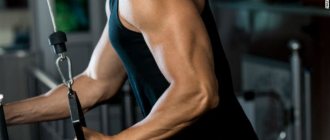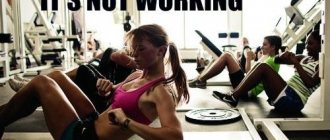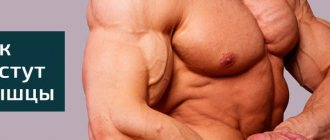Translation
Sergei Strukov.
Despite the fact that stretching has been performed for decades, modern research has almost completely discredited this type of recovery. Due to the refutation of the theory and the extremely low amount of scientific evidence of effectiveness, it has been suggested that this practice is outdated. Moreover, scientific research on stretching is highly inconsistent, with low validity and/or reliability.
The practice of stretching after exercise (training and competition) is very widespread and has been with us for many decades. Suggestions that post-exercise stretching reduces muscle soreness, restores “lost” or pre-exercise range of motion, and thus promotes recovery, became popular, particularly with analytical publications in the early 1960s (1). Since then, speculation about the benefits of stretching after exercise has been debunked, but this recovery method is still practiced (2).
What are stretches?
Stretching is “the application of force to muscle-tendon structures to change their length, usually to increase joint range of motion (ROM), reduce stiffness or soreness, or in preparation for physical activity” (3).
Although there are many types of stretching (Figure 1), static stretching appears to be the most common type of activity recommended after exercise. Urgent or long-term sprains are also distinguished. Acute stretching usually refers to single stretches of tissue for more or less than 30 seconds (4, 5). Long-term stretching refers to repeated stretching of tissue over several sets, days, or even weeks (6).
Dream
Sleep duration should be at least 8 hours! If you were unable to get enough sleep at night, it is advisable to sleep during the day for at least half an hour. Sleep is not only an excellent means of recovery, but also perfectly prepares for the upcoming load: the longer you sleep 1-2 days before the start, the higher your endurance and accuracy in performing technical actions. After intense training sessions, especially in the evening, it is not so easy to fall asleep, so try to finish training at least 3 hours before going to bed.
marathon and half marathon training plans and start training today!
What is recovery?
Restoration is traditionally understood as a one-stage model - when something lost is returned (8) or something returns to its original state (9). However, in sports, recovery from physical activity is a two-stage model - when what was lost is restored (for example, fatigue is reduced) and adaptation (supercompensation) to increased demands (6). Taking this into account, recovery is not complete until the athlete has reached a level of training that exceeds baseline values (the principle of supercompensation). Figure 2 shows this principle in a simplified form.
Trauma and psychological state
Even after full physical recovery, many athletes experience psychological discomfort. They are afraid to return to full training, there is a fear of failure, a fear of starting over. Many athletes experience psychological suffering from decreased physical activity, irritability, frustration, and insomnia during the recovery and recovery phase.
Post-traumatic stress disorder (PTSD) is a condition that affects 1 in 10 injured athletes. If you are diagnosed with this disease, you should definitely undergo treatment.
Treatment for PTSD includes:
- Prolonged Exposure Therapy, which helps the athlete recognize and regulate their thoughts about the trauma, teaches them to view PTSD as a stress rather than a personal weakness. The relaxation techniques on which the method is based help manage the physical and emotional state;
- drug therapy - it is used in combination with the first method if there is a need to eliminate symptoms of anxiety. Antidepressants are used for this.
You are not alone in a difficult situation; hundreds of people have experienced everything that happens to you and were able to overcome psychological difficulties and return to sports. In the meantime, replace physical activity with intellectual activity, find something you like and just recover.
Determine if you are ready to return to sports by taking a short test. If you answered positively to each statement, start training.
- The muscles in the injured area regained their original strength.
- Mobility in the joint is completely restored, and you can easily perform the entire range of motion.
- There is no pain.
- There is psychological readiness.
- No fear of training.
Does stretching after a workout improve recovery?
There are two main purposes of stretching after exercise:
- Reduce delayed-onset muscle soreness (hereinafter referred to as muscle soreness).
- Reduce stiffness (increase or restore original range of motion).
Before discussing the possibility of improving recovery from stretching, just remember that other post-workout modalities—heat, cold, vibration, massage, hydrotherapy, pain medications, and foam rolling—have been shown to reduce muscle soreness and increase ASD; thus improving recovery (10 – 18).
Performing static stretches after recovery exercises has a relatively long and somewhat convoluted history (6). This type of recovery was originally proposed in the early 1960s when a team of researchers decided that unaccustomed exercise caused muscle spasms (1). It was assumed that muscle spasm reduces blood flow to the muscles, causing pain, which increases muscle spasm - hence the process called the "pain-spasm-pain cycle." It was believed that stretching would break this cycle by improving blood flow to the muscle, thereby eliminating muscle soreness and speeding up recovery. The theory was subsequently refuted by other studies, which showed a decrease in blood flow, regional capillary oxygenation, and the rate of red blood cells entering the muscles during stretching (19 – 21). Thus, despite the refutation of the muscle spasm theory by Bobbert et al (22), the practice of stretching to improve recovery remains.
Muscle soreness and strains after exercise
Reducing muscle soreness after exercise is a great goal for improving recovery. Although many independent studies have been conducted to determine the effects of stretching on muscle soreness, almost all studies are rated as low to moderate in quality (2). According to a meta-analysis on the topic that included more than 2,500 subjects, stretching for recovery after exercise reduced the appearance of muscle soreness by 1 to 4 points on a 100-point scale. Although the indicator is statistically significant, the effect is very small and almost invisible. Unfortunately, despite the long history and frequent inclusion of this recovery strategy in many training programs, static stretching after exercise has little effect on muscle soreness.
Range of motion and stretching after training
Typically, mobility refers to the range of motion in a joint (AM) or joint system (for example, in the spine). Static stretching and pre-contraction stretching are probably the most commonly used stretches to develop or increase ASD—particularly after exercise.
You should be aware that there is a technical difference between “stretching,” which is commonly used to increase ASD, and “ASD exercises,” which could probably be called “mobility exercises” (23). What is the purpose of post-exercise stretching: 1) to restore “normal” or baseline ASD or 2) to increase ASD? If the former (restore the ASD), then it is recommended to use dynamic painless movements (6). If it's the latter (increase the ASD), then static stretching may be better.
However, the static stretching method typically requires the athlete to tolerate a “minor” amount of discomfort, which is caused by tensile stress in the muscles and tendons (6). The idea of causing pain (“a little discomfort”) after exercise in order to reduce pain and improve recovery seems somewhat counterintuitive. Okay, the idea behind static stretching is to develop or return to baseline ASD, but aren't the other recovery methods mentioned before just as good at achieving these goals? To our knowledge, there are no studies directly comparing the effects of these methods on increasing ASD with each other. Even so, if static stretching does not significantly outperform other methods, then it is not justified to perform it. In addition, although ASD increased after weeks of various static stretches, these improvements are thought to be due to increased stretch tolerance (the ability to withstand greater tensile forces) rather than tissue compliance (increased muscle length) (24 – 27).
Based on our current knowledge, after reviewing the available literature, it can be assumed that static stretching after exercise is inappropriate. Instead, other methods are recommended that not only reduce muscle soreness, but also painlessly improve ASD (for example, active recovery, including dynamic pain-free movements).
What happens in the body during rest
In professional sports jargon, there is a concept of supercompensation - and we are not talking about lazy lying on the couch. After intense exercise, energy reserves are depleted and muscle tissue becomes severely dehydrated. During the break, minor injuries, such as microtraumas, heal, and adaptation processes occur in the muscles, tendons and ligaments. In the best case scenario, the body will not only return to the state it was in before the workout, but will also overcompensate, immediately preparing for the next task and increasing its level of performance. If you wisely distribute periods of stress and rest, then over time the body’s performance will improve. “Regeneration is as important as the training itself. If you do not allow the body to relax and, on the contrary, load it with new exercises, then the condition can only worsen,” explains Frank Weinert.
Problems of modern stretching research
One of the main problems that applies to almost all stretching studies is the ability to correctly determine the intensity of stretching: how to measure the intensity of stretching? For example, how do you calculate or determine that stretching is slightly uncomfortable, moderately uncomfortable, or very uncomfortable in an experiment given the different pain tolerances of people. The situation is further complicated by the specificity of pain in relation to exercise, meaning that some people may tolerate greater strain with certain exercises compared to others (12). This also further complicates comparative studies—athletes may have a higher pain tolerance with quadriceps strains than with hamstring strains. Athletes are often encouraged to stretch without pain, but the line between pain and discomfort is unclear (6). Moreover, to our knowledge, no single measure has been proposed to reliably measure the level, intensity, or magnitude of stretching. In general, there are many problems with the reliability of stretch studies, making comparisons between similar studies very difficult.
Sports and injuries
The sports in which injuries occur most frequently include:
- games - football, basketball, volleyball;
- all types of martial arts;
- acrobatics, alpine skiing, artistic gymnastics, that is, complexly coordinated sports;
- speed-strength - javelin throwing, discus throwing, powerlifting, sprinting;
- technical types - motorcycle and motorsports, shooting and luge.
Each sport has characteristic damage and injuries. Tennis players often suffer from elbow damage or carpal tunnel syndrome, swimmers suffer from shoulder bursitis, basketball players, jumpers and volleyball players injure their knee joints, Achilles tendons, weightlifters can also damage their spine and get a muscle strain; Runners suffer from stress fractures in the foot, a meniscus tear.
Duration of the recovery period for three types of injuries:
- lungs - no more than 10 days;
- medium - up to 30 days;
- severe - over a month.
Prospects for further research
In addition to the potential difficulties in studying stretching regarding its methods and effects on recovery, the following areas of research are recommended for future research:
- Head-to-head comparisons of stretching with other recovery techniques and their ability to increase ASD.
- An indicator for quantifying the intensity of stretching.
- Determining acceptable pain for various stretches (eg, quadriceps and hamstrings).
How long does it take to recover?
How much time to spend on rest depends on many factors - for example, on the level of training: for beginners, it makes sense to give the body two days to recover. The intensity of the training also plays a role: “You can do walking every day, but for the more energy-intensive CrossFit you need a long break. It’s also important to remember that the older we get, the more time we need to recover.” You should focus on your pulse: if it is elevated, this may be a signal that it is time to take a break.
Instagram content
This content can also be viewed on the site it originates from.
Practical recommendations (key points)
Below are clinical data extracted from this review that can be applied in practice:
- Post-exercise stretching appears to have very little effect on muscle soreness 1 to 7 days after exercise.
- Although there is an observed increase in ASD after static stretching, it appears to be due to stretch tolerance rather than an increase in myotendinous length.
- To increase ASD from static stretching, moderate discomfort must be tolerated, which likely defeats the purpose of recovery (reducing soreness).
- ASD/mobility exercises with dynamic, pain-free movements may be better suited to regaining ASD lost after training.
- Static stretching decreases blood flow, regional capillary oxygenation, and the rate of red blood cell delivery to the muscles.
- Thus, other types of recovery are more beneficial, such as active recovery and water immersion (ice bath).
Source:
What constitutes an ideal holiday
“Our ideas about holidays have changed significantly over the past few years. We used to relax by squeezing our legs in a chair and holding a book in our hands. Modern technology offers us many options for recovery: from compression clothing that can be worn after sports, massage rollers and special drinks to infrared and cryosauna. However, these are only additional methods. The key to effective recovery is stress reduction, good sleep and a healthy diet. Perhaps in the future we will learn what effect the menstrual cycle and menopause have on regeneration. "Science is increasingly focusing on the fact that women are not small men, and there are significant differences in both training and regeneration."
Body massager D613, Bork, 16,000 rubles
Instagram content
This content can also be viewed on the site it originates from.











